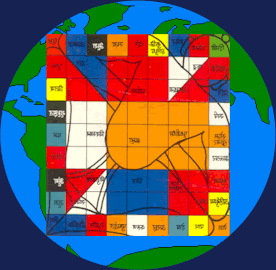|
Vaastushastra
and Yogashastra

Yogashastra
is the foundation of Vaastushastra. In Vaastushastra
every Vastu is considered to be a living entity. The 'prana'
(living breath) which is the essence of Yogashastra is
reflected in the Vaastushastra concept of positive
energy flow.
Almost
all the principles of Vaastushastra can be traced to
Yogashastra vision and practice. The Panch-Maha-Bhutas
(five great elements) are studied in detail in
Yogashastra. The individual qualities and effects of
permutations and combinations of these elements - earth,
water, fire, wind, and ether - are extensively utilised
in Vaastushastra to evaluate the virtues and vices of
directions in a Vastu. Vaastu-dosha or flaws in a
Vaastu can be treated with the help of helpful
properties of particular element.
'Ida'
or 'Chandra Nadi' and 'Pingala' or 'Surya Nadi', which
are important aspects of yogic practice, are reflected
in Vaastushastra as two-stream theory - Jaivik Urja and
Pranik Urja. 'Ida' stream gives stability, strength,
peace, prosperity and promotes life processes. Its zone
of influence extends over North and East directions. 'Pingala'
stream is associated with pain, hardship, misfortune,
sorrow and is considered detrimental to life. It has
control over the South and West directions.
In
defining or altering properties of various directions in
a Vaastu or a house, Vaastushastra has to take recourse
to Yogashastra principles.
Indian
yoga codified from esoteric practices that are thousands
of years old. It has developed several branches to
accommodate different personality styles. The major
yogas are Bhakti (a devotional approach that opens the
heart, it is best for those who are primarily
emotionally-oriented), Jnana (an intellectual approach
that leads to wisdom, it is best for those who are
primarily mentally-oriented), Karma (an active,
service-oriented approach, it is best for those who are
more extroverted and who find meaning mostly through
relationship), and Raja (a meditational approach, it is
best for those who are primarily oriented to the
practical aspects of a situation).
Raja
Yoga
For
those who are capable, Raja Yoga employs the most
powerful and direct techniques for spiritual
advancement. In addition, it provides a clear outline of
the stages of progress along the path. These teachings
were first systematised in the Yoga Sutras of Patanjali
( written around 300-500 AD).
The
eight traditional stages are:
1.
Yama (social ethics of non-violence, truth,
non-stealing, continence, and non-coveting)
2.
Niyama (personal ethics of purity, contentment,
ardour, study, devotion)
3.
Asana (discipline of the body through posture to
provide a sound base for taming the mind)
4.
Pranayama (discipline of the breath to refine the
base developed through asana)
5.
Pratyahara (beginning mental concentration, holding
to a single object for about 10-20 seconds). This is the
start of meditation, in proper. Achievement to this
level brings mental control over the sense gates, so
that one can withdraw from sense experience. This is
useful because it allows one to further purify the mind
and heart without the normal distractions of the mind
and senses.
6.
Dharana (intermediate mental concentration, holding
to a single object for 2-4 minutes)
7.
Dhyana (advanced mental concentration, holding to a
single object for 30-40 minutes)
8.
Samadhi (very advanced mental concentration, holding
to a single object for 6 hours or more). The most
advanced practitioners can remain in samadhi
indefinitely.
The
final practice of this meditational path is to connect
the samadhi state with ordinary day-to-day consciousness
so that a practitioner is in samadhi regardless of
whether he or she is meditating in total isolation or
performing daily chores in the normal bustle of people,
places, and events. In this way, the accomplished
meditator has quite literally passed beyond life's
sufferings but yet remains in the world. A spiritual
master of this stature experiences every moment as
pleasant and peaceful regardless of what may be
happening to her or his body and mind. For instance,
such a person would be aware of the body's torment when
suffering from some terrible disease, such as cancer,
but naturally remain in a serene state anyway.
cLICK
HERE for yoga and meditation remedies for vaastu-dosha

Rameshwar Prasad
invites you to the Wonderful World of Vastu Yoga
|

|
CONTACT
THE CONSULTANT
Engineer Rameshwar Prasad (B.Tech., M.Tech., P.G.D.C.A.,
P.G.D.M.) VAASTU INTERNATIONAL
49 C (Second Floor), Pocket- B, SFS
Flats,
Mayur Vihar,
Phase-III,
New Delhi - 110096,
INDIA
TeleFax : +91-11-22615299 (Landline), Mobile : +91-
9810105218
e-mail : vaastuinternational@yahoo.com
vaastuinternational@gmail.com
|

| 


